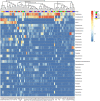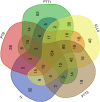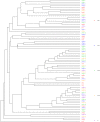Photodynamic therapy treats acne by altering the composition of the skin microbiota
- PMID: 36704881
- PMCID: PMC9838775
- DOI: 10.1111/srt.13269
Photodynamic therapy treats acne by altering the composition of the skin microbiota
Abstract
Background: Acne is the eighth-most prevalent inflammatory skin disease with no optimal treatment. Photodynamic therapy (PDT) is an effective treatment for severe acne.
Aims: The effect of PDT on the composition and diversity of skin microflora in severe acne patients was studied.
Materials and methods: A total of 18 patients with severe acne and 8 healthy individuals were selected for this study. Patients were treated with 5-aminolevulinic acid-mediated PDT once a week three times in total; the skin microbiome was measured by 16S ribosomal RNA gene sequencing before and after treatment (1 week after each PDT).
Results: The microflora composition was different between healthy controls and patients, and between patients before and after treatment. Alpha diversity indices were lower in patients than those in control. There were 15 bacterial genera with high relative abundance that had noticeable changes during treatment. At the genus level,particularly Cutibacterium acnes (C. acnes formerly Propionibacterium acnes), there was no statistically significant difference among different group. The abundances of Staphylococcus epidermidis and Staphylococcus aureus were low.
Discussion: The microbial composition is different between severe acne patients acne patients and healthy individuals. The therapeutic efficacy of severe acne treated with PDT is associated with the composition and diversity of skin microbiota.
Conclusion: The skin microbial composition changes after PDT treatment. PDT is an effective method for the treatment of severe acne.
Keywords: 16S sequencing; Cutibacterium acnes; photodynamic therapy; severe acne; skin microbiota.
© 2022 The Authors. Skin Research and Technology published by John Wiley & Sons Ltd.
Conflict of interest statement
The authors have no conflicts of interest to declare.
Figures












Similar articles
-
Modulation of skin microbiome in acne patients by aminolevulinic acid-photodynamic therapy.Photodiagnosis Photodyn Ther. 2021 Dec;36:102556. doi: 10.1016/j.pdpdt.2021.102556. Epub 2021 Sep 29. Photodiagnosis Photodyn Ther. 2021. PMID: 34600122
-
The effects of ALA-PDT on microbiota in pilosebaceous units of patients with severe acne: A metagenomic study.Photodiagnosis Photodyn Ther. 2021 Mar;33:102050. doi: 10.1016/j.pdpdt.2020.102050. Epub 2021 Jan 13. Photodiagnosis Photodyn Ther. 2021. PMID: 33453422
-
Association of Systemic Antibiotic Treatment of Acne With Skin Microbiota Characteristics.JAMA Dermatol. 2019 Apr 1;155(4):425-434. doi: 10.1001/jamadermatol.2018.5221. JAMA Dermatol. 2019. PMID: 30758497 Free PMC article.
-
Host-microbiome interactions and recent progress into understanding the biology of acne vulgaris.Microbiome. 2018 Oct 2;6(1):177. doi: 10.1186/s40168-018-0558-5. Microbiome. 2018. PMID: 30285861 Free PMC article. Review.
-
Recent advances in understanding Propionibacterium acnes ( Cutibacterium acnes) in acne.F1000Res. 2018 Dec 19;7:F1000 Faculty Rev-1953. doi: 10.12688/f1000research.15659.1. eCollection 2018. F1000Res. 2018. PMID: 30613388 Free PMC article. Review.
Cited by
-
Acne and the cutaneous microbiome: A systematic review of mechanisms and implications for treatments.J Eur Acad Dermatol Venereol. 2025 Apr;39(4):793-805. doi: 10.1111/jdv.20332. Epub 2024 Sep 13. J Eur Acad Dermatol Venereol. 2025. PMID: 39269130 Free PMC article.
-
Insights into microbial dysbiosis and Cutibacterium acnes CAMP factor interactions in acne vulgaris.Microb Genom. 2025 Jul;11(7):001449. doi: 10.1099/mgen.0.001449. Microb Genom. 2025. PMID: 40668089 Free PMC article.
-
Advances in Photonic Materials and Integrated Devices for Smart and Digital Healthcare: Bridging the Gap Between Materials and Systems.Adv Mater. 2025 Feb 4:e2416899. doi: 10.1002/adma.202416899. Online ahead of print. Adv Mater. 2025. PMID: 39905874 Review.
-
Targeted precision cryotherapy for acne vulgaris.Skin Res Technol. 2024 Sep;30(9):e70045. doi: 10.1111/srt.70045. Skin Res Technol. 2024. PMID: 39221850 Free PMC article. Clinical Trial.
-
Photodynamic Therapy with Protoporphyrin IX Precursors Using Artificial Daylight Improves Skin Antisepsis for Orthopedic Surgeries.Microorganisms. 2025 Jan 18;13(1):204. doi: 10.3390/microorganisms13010204. Microorganisms. 2025. PMID: 39858972 Free PMC article.
References
-
- Hay RJ, Johns NE, Williams HC, et al. The global burden of skin disease in 2010: an analysis of the prevalence and impact of skin conditions. J Invest Dermatol. 2014;134(6):1527‐1534. - PubMed
-
- Stamu‐O'Brien C, Jafferany M, Carniciu S, Abdelmaksoud A. Psychodermatology of acne: psychological aspects and effects of acne vulgaris. J Cosmet Dermatol. 2021;20(4):1080‐1083. - PubMed
-
- Samuels DV, Rosenthal R, Lin R, Chaudhari S, Natsuaki MN. Acne vulgaris and risk of depression and anxiety: a meta‐analytic review. J Am Acad Dermatol. 2020;83(2):532‐541. - PubMed
-
- Toyoda M, Morohashi M. Pathogenesis of acne. Med Electron Microsc. 2001;34(1):29‐40. - PubMed
MeSH terms
Substances
Grants and funding
LinkOut - more resources
Full Text Sources
Medical

